EMD SD70 series
| EMD SD70 series | |||||||||||||||||||
|---|---|---|---|---|---|---|---|---|---|---|---|---|---|---|---|---|---|---|---|
 Illinois Central SD70 locomotive #1004 | |||||||||||||||||||
| |||||||||||||||||||
| |||||||||||||||||||
| |||||||||||||||||||
The EMD SD70 is a series of road switcher diesel-electric locomotives produced by Electro-Motive Diesel in response to the GE Dash 9-44CW. Production commenced in late 1992[1] and since then over 5,700 units have been produced; most of these are the SD70M and SD70MAC models. All locomotives of this series are hood units with C-C trucks, while the SD70ACe-P4 has a B1-1B wheel configuration.
Prior to the SD70ACe and SD70M-2 models, all SD70 models were delivered with the self-steering HTCR radial truck.[note 1] The radial truck allows the axles to steer in curves which reduces wear on the wheels and railhead. With the introduction of the SD70ACe and SD70M-2 models, EMD introduced a new bolsterless non-radial HTSC truck as the standard truck for these models in an effort to reduce costs. The HTCR-4 radial truck is still an option.
All SD70ACe and SD70M-2 locomotives are, from the factory, equipped with one Nathan Airchime K5LLA-R1L airhorn mounted on a high-profile base. Due to height clearance restrictions, production models of the SD70ACe-T4 will be equipped with one K5LLA airhorn, mounted on a low-profile base, facing forward, and one "dual tone" K-13B airhorn, mounted over the rear headlight, facing rearward.
Models
SD70
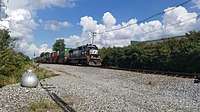
The SD70 uses the smaller standard cab or spartan cab, common on older 60 Series locomotives, instead of the larger, more modern comfort cab. This makes it hard to distinguish from the nearly-identical SD60, the only difference being the use of the HTCR radial truck instead of the HT-C truck mounted under the SD60. The main spotting feature is the difference in length between the two models - the SD60's 71 feet, 2 inches vs. the SD70's 72 feet, 4 inches. The SD70 also rides higher as its frame is approximately 1⁄2 inch (13 mm) higher than the SD60's. This model is equipped with direct current (DC) traction motors, which simplifies the locomotive's electrical system by obviating the need for computer-controlled inverters (as are required for alternating current (AC) power). It is equipped with the 4,000 horsepower (3,000 kW), 16-cylinder EMD 710 prime mover. One hundred and twenty-two examples of this model locomotive were produced for Norfolk Southern Railway (NS), Conrail (CR), Illinois Central Railroad (IC) and Southern Peru Copper Corporation (SPCC). Conrail's assets were split between Norfolk Southern (PRR) and CSX Transportation in 1999, and all 24 of Conrail's SD70 units went to NS. Other than the CR paint scheme these units were built to NS specifications and numbered (2557 - 2580) in series with their SD70's.
Production of the standard cab at EMD's London, Ontario plant ended in 1994. The 24 Conrail SD70s were assembled from kits at Conrail's (later NS's) Juniata Shops in Altoona, Pennsylvania, and the IC and SPCC SD70s were assembled from kits at Super Steel Schenectady. All SD70s are still in service with Norfolk Southern and Canadian National (CN), which merged Illinois Central in 1999. In February 2017, NS began a program to convert their SD70s from DC to AC, which will also have a new wide cab, and several other upgrades.
SD70M
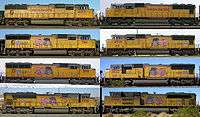
.jpg)
The SD70M has a wide nose and a large comfort cab (officially known as the "North American Safety Cab"), allowing crew members to ride more comfortably inside of the locomotive than the older standard cab designs. There are two versions of this cab on SD70Ms: the Phase 1 cab, which was first introduced on the SD60M, and is standard on the SD80MAC and SD90MACs, and the Phase 2 cab, which is a boxier design similar to the original three-piece windscreen on the SD60M, which is shared with the Phase 2 SD90MAC, SD89MAC, and SD80ACe. The Phase 2 cab has a two-piece windscreen like the Phase 1 windscreen but the design of the nose is more boxy, with a taller square midsection for more headroom.
The SD70M is equipped with D90TR DC traction motors and the 710G3B prime mover.[2] They are capable of generating 109,000 lbf (480 kN) of continuous tractive effort.[3] From mid-2000, the SD70M was produced with SD45-style flared radiators allowing for the larger radiator cores needed for split-cooling. Split-cooling is a feature that separates the coolant circuit for the prime mover and the circuit for the air pumps and turbocharger. There are two versions of this radiator: the older version has two large radiator panels on each side, and the newer version has four square panels on each side. This modification was made in response to the enactment of the United States Environmental Protection Agency's (EPA) Tier 1 environmental regulations. Also the truck was replace with HTCR-4, instead of HTCR-I on former model.
Production of the SD70M ceased in late 2004 as production of the SD70M-2 model began (the EPA's Tier 2 regulations went into effect on 1 January 2005). 1,609 examples of the SD70M model were produced. Purchasers included CSXT, New York Susquehanna & Western (NYSW; part of EMDX order no. 946531[4]), Norfolk Southern and Southern Pacific (SP; now part of the Union Pacific Railroad), but the vast majority were purchased by Union Pacific.
An order of SD70Ms made history when Union Pacific ordered 1000 units of the model (UP 4000 through UP 4999, inclusive). This order was later extended by nearly 500 additional units (UP 3999, and below) and (UP 5000, and above).
This locomotive model is also built for export, and is still catalogued by EMD (at 4,300 hp or 3,200 kW). CVG Ferrominera Orinoco has 6 SD70Ms that were built as an add-on order to UPs FIRE cab equipped SD70Ms. Companhia Vale do Rio Doce (CVRD) in Brazil has ordered 55 of this model for service in Carajas pulling trainloads of iron ore. Since CVRD track is gauged at 1,600 mm (5 ft 3 in), a wider bogie, the HTSC2, was designed for these units by EMD.[5]
SD70I
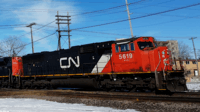
The SD70I is a version of the SD70M which has been fitted with a cab that is isolated from the frame of the locomotive with rubber gaskets (officially known as a "WhisperCab"). The isolation reduces noise and vibration from the prime mover. A seam is visible across the nose and on the long hood where the cab connects with the body. 26 examples of this model locomotive were produced, all for Canadian National Railway. The WhisperCab feature was incorporated into some SD70MAC and later models.
SD70MAC

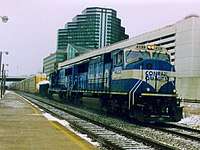
The SD70MAC (colloquially known as a "Mac" or a "70 Mac") is very similar to the SD70M and SD70I; the main difference being that the SD70MAC uses AC traction motors. Production of the model commenced in 1993, competing against GE's AC4400CW.[6] AC motors, while simpler and more reliable than DC motors, require expensive inverters to generate a variable-frequency AC signal, raising the locomotive's purchase cost substantially. The majority of SD70MAC models were produced with the 4,000 horsepower (3,000 kW) EMD 710 prime mover[7] while later units are rated at 4,300 horsepower (3,200 kW) and feature EMD SD45-style flared radiators. The Alaska Railroad ordered their locomotives with head-end power to make them suitable for both freight and passenger service. No other railroad ordered this variant.[8] The trucks were replaced with HTCR-4, instead of HTCR-I on former model.
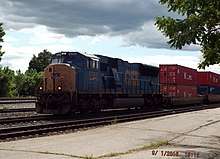
The SD70MAC is no longer produced due to EPA regulations and has been replaced by the SD70ACe. 1,109 examples of this model were produced. It was purchased by Burlington Northern Railroad (now BNSF Railway), BNSF, Conrail (units now owned by CSX), CSX Transportation, Transportación Ferroviaria Mexicana (TFM; units now owned by Kansas City Southern Railway (KCS)), and the Alaska Railroad.
SD70ACe
The SD70ACe is the successor to the older SD70MAC. Built from 2004 to 2014 in the United States and from 2004 to 2012 in Canada, the SD70ACe was originally designed to comply with EPA Tier 2 locomotive emissions regulations. Beginning in 2012, newly built SD70ACe's were EPA Tier 3 compliant.[9] SD70ACes are equipped with EMD's 16-710-G3C-T2 prime mover, rated at 4,300 horsepower (3,200 kW); later Tier 3 models are rated at 4,500 horsepower (3,400 kW).[10] They are rated at 157,000 lbf (700 kN) continuous tractive effort (191,000 lbf (850 kN) starting). Braking effort is rated at 106,000 lbf (470 kN).[10]
Although mechanically similar to earlier SD70 units, the SD70ACe rides on a new underframe and uses mostly new sheet metal above the frame. Electrical cables and air lines have been routed beneath the walkways on opposite sides, allowing easier access for maintenance. Continuing the designs of the SD80 and SD90 series, the radiator on the locomotive is nearly as wide as the cab, the center hood section is a step down below the roofline, and the dynamic brakes have been moved to the rear of the hood. The SD70ACe uses the cab design of late-model SD90MAC-H units, which uses rectangular window glass and is externally different from the two cab variations used on earlier SD70M and SD70MAC units. In 2008, EMD standardized the isolated cab on subsequent SD70ACe's after non-isolated cab units were restricted from leading on BNSF Railway due to excessive cab vibration.
Purchasers included ArcelorMittal, BNSF Railway, Canadian National Railway, CSX Transportation, Ferromex, Kansas City Southern Railway, Montana Rail Link, Norfolk Southern Railway, CVG Ferrominera Orinoco, Union Pacific Railroad, Quebec North Shore and Labrador Railway, BHP Billiton, and shortline Arkansas and Missouri Railroad.

In 2012, EMD also built four models known as the SD70ACe-P6. These units, unlike previous SD70ACe's, have one inverter per axle on the trucks, rather than EMD's traditional one inverter per truck design. Four of EMD's SD70ACe-P6 demonstrators were sold to Canadian National Railway, numbered 8100-8103, and all have been repainted into company paint. The last unit (#8103) retained the demonstrator livery until late 2015 when it was spotted freshly repainted.[11]
In 2014, BNSF Railway took delivery of 20 SD70ACe-P4 units, numbered 8500-8519. This model was designed with a B1-1B wheel arrangement to compete with GE's ES44C4 model, which has an A1A-A1A wheel arrangement. Two of EMD's demonstrator SD70ACe-P4's went to Tacoma Rail in late 2014 for a 5-year lease.
On January 1, 2015, the United States Environmental Protection Agency's Tier 4 locomotive emission regulations went into effect. EMD could not successfully modify the SD70ACe's 2-stroke 710 series prime mover to be Tier 4 compliant, thus limiting Tier 3 compliant EMD SD70ACe production to Tier 4 credit units for use in the United States. EMD has continued building Tier 3 SD70ACe's for Ferromex (4100-4118), Ferrosur (4119-4133), and Kansas City Southern de Mexico (4200-4224) at Bombardier's Ciudad Sahagun, Mexico plant. These locomotives are restricted to Mexico-only operation and cannot cross the US border (just as Canadian National's newest Tier 3 GE ES44AC's are restricted to Canadian use only). 2014 was the final year of EMD producing SD70ACe's powered by the 710 series 2-stroke engines for use in the USA except as Tier 4 credit units EMD was entitled to build based on previously-earned emissions credits. This model would later be succeeded by the SD70ACe-T4.
In March 2016, EMD replaced the standard cast HTCR-4 trucks on NS SD70ACe 1000 with the new fabricated HTCR-6 trucks for testing. UP and BNSF plan to test the new HTCR-6 trucks on some of their SD70ACe units also.
Union Pacific Railroad received 273 additional SD70ACe units in 2014 and 2016. These are referred to as SD70AH, H for Heavy, because they are ballasted to 428,000 lbs instead of the standard "ACe's" 420,000 lbs.
On October 19, 2017, in San Antonio, Texas, Union Pacific officially unveiled UP 1943, the "Spirit of the Union Pacific", an SD70AH renumbered from UP 9026. The unit commemorates the branches of the US Military, with the name being a reference to a B-17 the railroad sponsored during World War II of the same name.[12]
SD70M-2

The SD70M-2 is a DC traction version of the SD70ACe, and is nearly identical to the SD70ACe. Production began in 2005.[13] SD70M-2 models are equipped with the 16-710G3C-T2 prime mover which is rated at 4,300 horsepower (3,200 kW).[14]
The SD70M-2 was not a big seller, as most major carriers were purchasing AC traction locomotives exclusively by the time of its introduction. Only 331 SD70M-2's were built. Canadian National Railway owns 190 units, and 130 units are owned by Norfolk Southern Railway. 8 units owned by Electro-Motive Diesel and 3 units owned by CIT Financial were leased by Florida East Coast Railway until early 2015. CN 8964, built December 2010 was the last SD70M-2, and will most likely be the last new DC traction locomotive since holdouts, CN and NS, have embraced the AC traction concept.
SD70ACe-T4
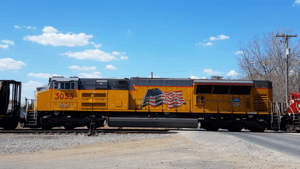
The SD70ACe-T4 is the Tier 4 emissions standards-compliant version of the SD70ACe. The first locomotive was built in summer 2015, and made its debut at the Railway Interchange Expo in Minneapolis, Minnesota during the weekend of October 3–4, 2015. It features a new 4-stroke engine called the EMD 12-1010 - a V12 with 1010 cu.in displacement for each cylinder. This new prime mover has a two-stage turbocharger system consisting of three turbos; one turbo (the primary/high pressure turbo) for low-mid RPM and two turbos (the secondary/low pressure turbos) for mid-high RPM. The results of this setup are higher power throughout a broader RPM range, better fuel efficiency, and lower emissions. An EGR system is applied as well, allowing the engine to achieve Tier 4 without the use of urea aftertreatment. Another new feature of this engine is the Double-Walled Fuel Injection System that increases safety and provides simplified maintenance works.
This new engine is capable of producing 4,600 hp, but only 4,400 tractive horsepower.[15] With a new computer software for the on-board computer and one inverter per axle (or "P6"; EMD named it "Individual Axle Control") - unlike most of previous EMD locomotives that use one inverter per truck, the SD70ACe-T4 is capable of generating 200,000 lbf. (889.64 kN.) of starting tractive effort, and 175,000 lbf. (778.75 kN.) of continuous tractive effort. Meanwhile, its dynamic braking effort is as much as 105,000 lbf. (467.25 kN.) The amount of starting tractive effort is equal to that of the 6,000 hp SD90MAC-H while, on the other hand, its continuous tractive effort is higher than that of the SD90MAC-H (175,000 lbf. vs. 165,000 lbf.). Due to the "Individual Axle Control", the locomotive will have improved reliability performance and maintenance. The units are also equipped with "radial bogies" which offer increased adhesion and better ride quality.[15]
While it retains the basic SD70 designation, the locomotive has several major new features that set it apart from its successful ancestor such as a vibration-isolated powertrain, and alternator start capability. In addition, it features a newly redesigned cab reminiscent of the earlier SD70M, even bringing back the classic "teardrop" windshields first introduced on the FP45 in December 1967; new fabricated trucks; a longer frame (76 ft. 8 in / 23.37 m); longer radiators with three radiator fans instead of two; an additional step; and a smoother long hood roofline.[16][17][18][19]
Fifteen SD70ACe-T4 demonstrators were built at Muncie, IN by November 2016. Union Pacific Railroad is the first customer to order SD70ACe-T4's. U.P. 3012-3014, the first production SD70ACe-T4's, were assigned to active service in early November 2016.
U.P. will acquire 100 SD70ACe-T4's: 12 former demonstrators will be rostered as UP 3000-3011, and 88 production units 3012-3099. 3012-3056 were built in the Sahagun Mexico plant by Bombardier. 3057-3099 will be built at Muncie, IN following completion of the tier 4 credit SD70ACe's UP 8997-9096. All UP SD70ACe-T4's will be classified as SD70AH's, similar to the 273 SD70AH's they already own.
EMDX 1501 will remain in Progress Rail Services ownership as a test bed. SD70ACeP4-T4's EMDX 1603 and 1604 {4 traction motors} were built and painted as demonstrators for the BNSF Railway.
As of August 2018, Norfolk Southern and CSX have each ordered 10 SD70ACE-T4's.
SD70ACe/LCi
The SD70ACe/LCi is a low clearance, export version of the SD70ACe. The LCi in the model designation stands for Low Clearance international as these locomotives are designed to negotiate the tight clearances under the mine equipment. External differences between the SD70ACe and SD70ACe/LCi models include the addition of marker lights, number boards located lower on the nose rather than on top of the cab, windscreen protector panels (to deflect abrasive iron ore when in mid train position), fire suppression canisters, louvre style vents, different horn and subtle differences with handrails.[20]
In 2004, BHP Billiton ordered a first batch of 14 SD70ACe/LCi locomotives for use on iron ore trains in the Pilbara region of Western Australia.[21] It operated in 2015 a fleet of 23 SD70ACe/LCi locomotives beside of 142 standard SD70ACe, from which the newest locomotives are built in 2014.[22]
The first member of the class (4300) was purchased for parts and dismantled upon arrival in Australia. This was because it was cheaper to purchase a complete locomotive than buy the components individually.[23][24] The first batch of SD70ACe/LCi's (4301-4313) was ordered in 2004 and named after sidings on the BHP system.[25][26] Since it did not have the newer, isolated cab of the second and subsequent batches it was traded in to the supplier for locomotives with newer cab assemblies.[22]
The second batch of locomotives (4314-4323) arrived between August and November 2006.
An order for a third batch of 13 SD70ACe/LCi's (4334-4346) was placed in August 2007, but such was the demand for locomotive power in the Pilbara region, a deal was done with BNSF Railway for BHP Billiton to purchase ten standard North American SD70ACes (4324-4333) that were in build as their 9166, 9167, 9184-9191. Construction was sufficiently advanced when the deal was concluded for them to have been painted, hence they were delivered in BNSF orange livery. Some modifications have been made to bring them in line with the rest of the fleet. A fifth batch of SD70ACe's (Numbers 4347-4355) was delivered in July 2009.[27][23]
An additional 18 units (numbers 4356-4373) were delivered in the second half of 2010, bringing the total of SD70ACe type locomotives in service to 72.[24] In March 2012, BHP Billiton ordered a further 80.[28]
In July 2012 fellow Pilbara operator, Fortescue Metals Group, took the delivery of the first of a fleet of 19, later extended to 21 (701-721).[24][29][30]
In 2018, some BHP SD70ACE/LCis were sold to Montana Rail Link.
SD70ACS
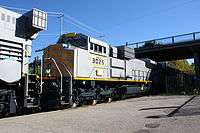
The SD70ACS is a 4,500 horsepower (3,400 kW) AC variant for heavy haul freight, used in desert environments. The first 25 units were ordered for Saudi Railway Company in April 2009 and assembled in the London, Ontario plant for delivery in the second half of 2010. Special features include a pulse filtration system, movable sand plows, EM2000 control system and FIRE display system.[31]
Mauritania's Société Nationale Industrielle et Minière placed a contract for six SD70ACS locomotives in October 2010.[32]
In July 2011 Etihad Rail ordered seven SD70ACS locomotives for delivery in 2012.[33]
SD70ACe-BB
In October 2015, EMD started producing SD70ACe-BB locomotives for Brazilian narrow gauge railroads.
SD70ACe/45
The SD70ACe/45 is a diesel-electric locomotive built by EMD plant in Sete Lagoas, MG Brazil. Different from the SD70ACe in North America, the SD70ACe/45 has a longer frame (76 ft. 6 in.) and three radiator fans on the radiator section since it uses the same car body of the SD80ACe produced by EMD plant in London, Canada to Vale mining in Brazil. It uses 1,600 mm (5 ft 3 in) gauge. 80 SD70ACe/45s had been built.
SD70ACU

The SD70ACU was first built by EMD and later rebuilt by Norfolk Southern. It is originally an SD90MAC (or well known as SD9043MAC) that has been rebuilt to renew its electrical components and replace the cab with the new EMD Phase-II cab to comply with the most recent safety requirements. These locomotives are similar to the SD70ACe model, but the main body features are all reminiscent to the SD90MAC features. They also have the latest EMD cab that meets current FRA crashworthiness standards. These locomotives also have the Ultra Cab II, locomotive speed limiter (LSL), and cab signals. 100 of the 110 units Norfolk Southern purchased were originally SD9043MACs previously operated by the Union Pacific Railroad. The other 10 units were acquired by a trade with Cit Group for MP15DC's. All NS-owned SD9043MACs are slowly being rebuilt by NS at its shops in Altoona, Pennsylvania. As of July 15, 2018, 100 SD70ACU units have been completed and released to active service.
SD70ACC
Norfolk and Southern rolled out the first SD70ACC on September 18, 2018 in Altoona, PA.
The latest in Norfolk Southern’s DC to AC conversion program is SD70ACC 1800, seen here fresh out of the Juniata Paint Shop in Altoona, Penn. Originally built in 1994 as EMD SD70 #2537, 1800 was rebuilt by Progress Rail’s facility in Muncie, Indiana, to include a new safety cab and electrical upgrades to provide AC traction. The yellow color represents Progress Rail's parent company, Caterpillar. The unit will work in revenue service across the NS system.
Operators
North America
- ArcelorMittal, operated by Cartier Railway
- 5 SD70ACe units, numbered 9001-9005. Delivered in May 2013.
- Alaska Railroad
- 28 SD70MAC units, numbered 4001-4016 and 4317–4328.[34] The units numbered 4317–4328 have flared radiators for Tier 1 compliance and are equipped with head-end power (HEP) generators for passenger service.
- Arkansas and Missouri Railroad
- 3 SD70ACe units, numbered 70-72. Units are ex-EMDX 1201-1203.
- BNSF Railway
- 786 SD70MAC units, numbered 8800–8989, 9400–9499 and 9504–9999.[35] Unit 8876 was retired and scrapped following a wreck. Units 9400–9716 are ex-Burlington Northern Railroad. 9400-9579 are built without the isolated cab while 9580-9716 are built with the isolated cab. Some 9500 series MACs were sold to PRLX in 2017.
- 640 SD70ACe units, numbered 8400-8499, 8520-8599, 8749-8799, 8990-9158, & 9160-9399.[35] 9159 wrecked, rebuilt, and renumbered 8749.
- 20 SD70ACe-P4's, numbered 8500-8519.
- 2 SD70ACeP4-T4 units, EMDX 1603 and 1604. Both units are still in road tests conducted by BNSF.
- Canadian National Railway
- CIT Group
- 3 SD70M-2 units, numbered 140–142.[37] All are ex-EMD demonstrators.
- CSX Transportation
- 25 SD70M units, numbered 4675–4699.[38] All are ex-EMD demonstrators. All units were sold to Progress Rail (PRLX) in mid 2018.
- Originally 220 SD70MAC units, numbered 4500–4589 and 4701–4830.[38] Unit 4716 wrecked and retired in 2014. Units numbered 4575–4589 are ex-Conrail units. 16 of CSX's SD70MAC locomotives (units 4501-4506, 4510-4512, 4516-4520, 4522 & 4523) were sold to Four Rivers Transportation, 16 of which went to the Paducah & Louisville Railway and its subsidiary, the Evansville Western Railway (EVWR 4517, 4519 and 4520). PAL repainted three SD70MACs in special livery: one in University of Kentucky Blue & White colors to mark the school's 2012 NCAA Basketball Championship (PAL 2012, ex-4505). They painted a second unit into University of Louisville Red & White to mark their 2013 NCAA Basketball Championship (PAL 2013, ex-4506). The third special unit, PAL 4522, is also painted in University of Kentucky blue and white, and commemorates all 8 of UK's championship wins. All units are used in regular freight service, between Paducah and Louisville,KY.
- 20 SD70ACe units, numbered 4831–4850. 4839 retired due to an alternator failure. All retired in 2017 and sold to Progress Rail (PRLX), 4834 vandalized with C&O lettering in April 2018.
- Electro-Motive Diesel Leasing
- 3 SD70ACe units, numbered 1207, 2012, & 4223. 1207 is an SD70ACe-P4.
- 1 SD70ACe-T4 unit, numbered 1501.
- Ferromex
- 97 SD70ACe units numbered 4000–4096.[39]
- 34 SD70ACe units numbered 4100-4133, built in 2015. These units are not Tier 4 compliant and are thus restricted to Mexico. 4119-4133 are assigned to Ferrosur, and are specially equipped with experimental sheet-metal awnings or "elephant ears" over the radiator air intakes to combat excess heat and enhance engine cooling in the many tunnels through which they must operate.
- Florida East Coast Railway
- 8 SD70M-2 units, numbered 100–107.[40] All eight units were returned to lessor in early 2015. Former FEC 100 & 102 now Providence and Worcester Railroad 4301 & 4302, respectively. Former FEC 101 & 103 now Vermont Railway 431 & 432, respectively.
- Illinois Central Railroad
- 40 SD70 units, numbered 1000–1039.[36] Units 1006, 1013, 1014 & 1023 were wrecked and retired.
- Kansas City Southern Railway
- 75 SD70MAC units, numbered 3900–3902, 3904–3905, 3907, 3910–3916, 3918, 3920–3921, 3924–3926, 3928–3930, 3932, 3934–3935, 3937–3938, 3941–3942, 3944, 3946–3948, 3951, 3953, 3955, 3957, 3961–3964, 3966–3968, 3970, 3972–3973.[41] All are ex-Transportación Ferroviaria Mexicana (TFM) units.
- 153 SD70ACe units, numbered 3997–4059, 4100–4129, & 4140-4199.[41] Units 3997–3999 are ex-EMD demonstrators.
- Kansas City Southern de México
- 75 SD70ACe units, numbered 4060–4099, 4130-4139, & 4200-4224. Units 4200-4224, built in 2015, are not Tier 4 compliant and are thus restricted to Mexico.
- Luminant (formerly Texas Utitilies Generating Co.,TUGX)
- 2 SD70ACe units, numbered 5308 & 5309. Units are ex-EMDX 1204 & 1205 respectively.
- Montana Rail Link
- 25 SD70ACe units, numbered 4300–4315 & 4400-4408.
- Norfolk Southern Railway
- 80 SD70 units, numbered 2501–2580.[42] Units 2557–2580 are ex-Conrail units, but built to NS specifications.
- 68 SD70M units, numbered 2581–2648.[42]
- 3 SD70M units, numbered 2797-2799. Units ex-New York, Susquehanna & Western 4050, 4052, 4054. Acquired in September 2014.
- 130 SD70M-2 units, numbered 2649–2778.[42]
- 175 SD70ACe units, numbered 1000–1174.[42] 1065-1074 painted in special historic "heritage" schemes honoring important NS predecessor roads.
- 100 (eventually 110) SD70ACU units, rebuilt from Ex-UP and Ex-CIT SD90MACs. Other units are in service as SD9043MAC's or are stored.
- Providence and Worcester Railroad
- 2 SD70M-2 units, No. 4301 and 4302. See the section for Florida East Coast.
- Quebec North Shore and Labrador Railway
- 23 SD70ACe units, numbered 501–523. Units 501-507 were built in December 2009; 508-513 were built in August 2011; and 514-523 were built in December 2012.[43]
- Tacoma Rail
- 2 SD70ACe-P4 units, numbered 7001 & 7002. Units are ex-EMDX 1211 & 1212.[44]
- Union Pacific Railroad
- 1,452 SD70M units, numbered 2001-2002, 3778–3984, 3986-4140, 4142-4689, 4692-5231 (Nos. 2001-2002 are ex 4690-4691, 3778 is ex 4141, and No. 3985 is occupied by steam locomotive 3985).[45] Unit 4014, along with 4884, was given the honor of escorting UP's 4-8-8-4 Big Boy move to Cheyenne for restoration, and eventual return to the active roster. To avoid confusion, the "Big Boy" was renumbered UPP 4014.[46] Units 4530, 4545, 4687, 4811, 4855, 5070, and 4929 were wrecked and retired from service. Units 3974-3984 & 3986-3999 are ex-Southern Pacific 9800-9824.
- 518 SD70ACe units, numbered 1982, 1983, 1988, 1989, 1995, 1996, 4141, 8309-8378, 8380-8382, 8384-8395, 8397-8422, 8424-8823.[45] The 19xx units comprise Union Pacific's "Heritage Fleet". Unit 1982 (ex-8379) wears the "Missouri Pacific Proud Heritage" livery. Unit 1983 (ex-8383) wears the "Western Pacific Proud Heritage" livery. Unit 1988 (ex-8396) wears the "Missouri-Kansas-Texas Proud Heritage" livery. Unit 1989 (ex-8521 (1st)) wears the "Denver & Rio Grande Western Proud Heritage" livery. Unit 1995 (ex-8522 (1st)) wears the "Chicago & North Western Proud Heritage" livery. Unit 1996 (ex-8523 (1st)) wears the "Southern Pacific Proud Heritage" livery; and was the locomotive to pull the "Big Boy" from its resting place at Pomona, CA. Unit 4141(ex-8423) wears the "George Bush 41st President" livery.[45] Numbers 8521-8523 were re-issued to subsequent new locomotives. 273 additional ACe units, numbered 8824-9096, were built in 2014 and 2016. Classified by UP as SD70AH's they are ballasted to 428,000 lbs. instead of the standard 420,000 lbs. 8824-8996 were built in 2014, and Tier 4 credit units 8997-9096 were built in 2016. Unit 1943 (ex-9026) painted in a special paint scheme to honor U.S. troops.
- 100 SD70ACe-T4 units, numbered 3000-3099. When testing on other carriers is completed, former EMDX demonstrators 1502-1505, 1601, 1602, and 1605-1610 will become UP 3000-3011. UP 3012-3099 will be the first production units of this model. EMDX 1501 will be retained by Progress Rail Services as a test bed unit. EMDX 1603 and 1604 are "P4's" destined for BNSF Railway.
- Vermont Railway
- 2 SD70M-2 units, No. 431 and 432. See the section for Florida East Coast.
- Progress Rail Leasing (PRLX)
- 14 SD70MAC units, numbered 9551-9564, all units are ex-Burlington Northern Railroad and later BNSF. Units are currently on lease to Norfolk Southern Railway.
- 19 SD70ACe units, numbered 4831-4850, all units are former CSX . Units are currently on lease to Norfolk Southern Railway and Canadian National Railway.
- 24 SD70M units, numbered 4675-4699, all units are former CSX and are also former EMDX demonstrators 7000-7024. Units are currently on lease to Union Pacific Railroad.
International
- BHP Billiton
- 19 SD70ACe units, numbered 4324–4333 and 4347-4355. 4324-4333 were originally intended for BNSF Railway and purchased by BHP Billiton when on the production line.[24]
- 173 SD70ACe/LCi units, numbered 4300–4323, 4334-4346 and 4356–4491[24]
- Etihad Railway
- Ordered 7 SD70ACS units
- Ferrominera Orinoco
- 6 SD70M units, numbered 1052-1057
- Fortescue Metals Group
- 21 SD70ACe/LCi units, numbered 701-721[30]
- Mauritania Railway
- Ordered 6 SD70ACS units
- Saudi Railway Company
- 25 SD70ACS units
- Southern Peru Copper Corp.
- 2 SD70 units, numbered 60 & 61. Assembled in April 1999, these were the last standard or "spartan" cab units produced by EMD, and were built as an add-on to Illinois Central SD70's 1020-1039, even matching their specifications.
- Carajás Railroad (EFC) - Companhia Vale do Rio Doce
- América Latina Logística, now Rumo Logística
- 7 SD70ACe/45[47] units, numbered 618-624, (wide gauge 1,600 mm (5 ft 3 in)).
- Eldorado Brasil
- 21 SD70ACe/45[47] units, numbered 9553-9573, (wide gauge 1,600 mm (5 ft 3 in)), operated by América Latina Logística.
- Valor da Logística Integrada
- 62 SD70ACeBB[48] units, numbered 8332-8393, (narrow gauge 1,000 mm (3 ft 3 3⁄8 in)), operate on the lines of Ferrovia Centro-Atlântica. An additional 16 locomotives should be delivered in the first half of 2017.[49]
- 52 SD70ACe/45 units, numbered ??-??, (wide gauge 1,600 mm (5 ft 3 in)), operate on the lines of Ferrovia Centro-Atlântica and Ferrovia Norte-Sul.
- Demonstrator manufactured in Brazil
- 3 SD70ACe units, numbered 7044-7046, (wide gauge 1,600 mm (5 ft 3 in))
- 2 SD70ACeBB units, numbered 8795-8796, (narrow gauge 1,000 mm (3 ft 3 3⁄8 in))
Gallery
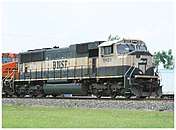 BNSF Railway SD70MAC #9819 in January 2008
BNSF Railway SD70MAC #9819 in January 2008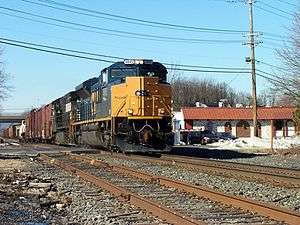 CSX Transportation SD70ACe 4845 leads train Q410 through South Plainfield, New Jersey in February 2005
CSX Transportation SD70ACe 4845 leads train Q410 through South Plainfield, New Jersey in February 2005 Norfolk Southern Railway SD70M-2 #2700 leads train 21M through Easton, Pennsylvania in July 2006
Norfolk Southern Railway SD70M-2 #2700 leads train 21M through Easton, Pennsylvania in July 2006 EMD SD70ACe/45 pertencente a VLI #6518 in Paratinga-SP in July 2013
EMD SD70ACe/45 pertencente a VLI #6518 in Paratinga-SP in July 2013- EMD SD70ACe/45 #9558 Eldorado in Paratinga-SP in July 2013
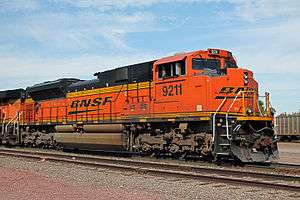 BNSF SD70ACe #9211 at Lincoln, Nebraska in October 2014
BNSF SD70ACe #9211 at Lincoln, Nebraska in October 2014
Notes
- ↑ Most other EMD six-axle locomotives were mounted on EMD's HT-C truck.
Footnotes
- ↑ Solomon 2011
- ↑ Solomon 2006
- ↑ Solomon 2006
- ↑ "Order # 946531, SD70M". The UNofficial EMD Homepage. Retrieved 24 January 2012.
- ↑ "SD70M for CVRD". Electro-Motive Diesels. Archived from the original on 2008-05-15. Retrieved 2005-12-01.
- ↑ Solomon 2011
- ↑ "Diesel-Electric Locomotive SD70MAC" (PDF). Siemens. Archived from the original (PDF) on 14 November 2004.
- ↑ "Locomotives Reference List" (PDF). Siemens.
- ↑ Solomon 2011
- 1 2 ElectroMotive. "SD70ACe". Retrieved 26 January 2012.
- ↑ http://www.railpictures.ca/?attachment_id=21116
- ↑ http://www.railpictures.net/photo/634918/
- ↑ Solomon 2011
- ↑ ElectroMotive. "SD70M-2". Retrieved 26 January 2012.
- 1 2 http://s7d2.scene7.com/is/content/Caterpillar/C10678841
- ↑ "EMD ships first Tier 4 locomotive to Railway Interchange show". Trains Magazine. 29 September 2015. Retrieved 30 September 2015.
- ↑ "EDM SD70ACe-T4 Freight Locomotive". www.progressrail.com. Retrieved 2016-01-07.
- ↑ "EMD SD70ACe-T4 Locomotive". Progress Rail. Retrieved 2016-01-07.
- ↑ "EMD unveils its first Tier 4 diesel locomotive". Railway Gazette. Retrieved 2016-07-27.
- ↑ Montgomery 2009
- ↑ Montgomery 2009
- 1 2 "BHP Billiton Iron Ore Road Locomotive Roster". Pilbara Railway Pages. Retrieved 2016-01-07.
- 1 2 Oberg 2010, pp. 435–436
- 1 2 3 4 5 Clark 2010, pp. 215–218
- ↑ Montgomery 2009
- ↑ BHP Billiton Loco Roster Archived 8 March 2012 at the Wayback Machine. Pilbara Railways
- ↑ Montgomery 2009
- ↑ "BHP Billiton places large heavy haul locomotive order". Railway Gazette International. 2 March 2012. Archived from the original on 14 March 2012. Retrieved 14 March 2012.
- ↑ Downer to build 19 locomotives for Fortescue Railway Technology 26 June 2012
- 1 2 Fortescue Rail Fact Sheet Archived 23 February 2014 at the Wayback Machine. Fortescue Metals Group May 2013
- ↑ "Electro-Motive Diesel, Inc. Wins New Locomotive Contract for 25 SD70ACS Locomotives from Saudi Railway Company (SAR)". EMD. Retrieved 2016-01-07.
- ↑ "High temperature locomotives ordered from EMD". Railway Gazette International. 20 October 2010.
- ↑ "Etihad Rail orders EMD locomotives". Railway Gazette International. 1 August 2011.
- ↑ "Alaska Railroad's Motive Power". The Diesel Shop. Retrieved 24 January 2012.
- 1 2 "Burlington Northern Santa Fe Motive Power Fleet". The Diesel Shop. Retrieved 25 January 2012.
- 1 2 3 "Canadian National Motive Power Summary". The Diesel Shop. Retrieved 25 January 2012.
- ↑ Belote, Joseph; Craig, R (23 January 2012). "CIT Rail Resources". The Diesel Shop. Retrieved 25 January 2012.
- 1 2 Craig, R (23 January 2012). "CSX Motive Power Summary". The Diesel Shop. Retrieved 25 January 2012.
- ↑ Komanesky, John (17 January 2012). "Ferrocarril Mexicano (Ferromex) Motive Power". The Diesel Shop. Retrieved 25 January 2012.
- ↑ "Florida East Coast Motive Power". The Diesel Shop. 16 November 2008. Retrieved 25 January 2012.
- 1 2 "Kansas City Southern and KCS de Mexico (A Work-in-Progress)". The Diesel Shop. 26 December 2011. Retrieved 24 January 2012.
- 1 2 3 4 "Norfolk Southern Motive Power". The Diesel Shop. 4 January 2011. Retrieved 24 January 2012.
- ↑ Diesel Era Magazine, October–November 2013, vol.24-5
- ↑ http://trn.trains.com/news/news-wire/2014/09/tacoma-rail-acquires-two-sd70ace-p4s
- 1 2 3 "Union Pacific Motive Power". The Diesel Shop. 21 January 2012. Retrieved 25 January 2012.
- ↑ Union Pacific RR
- 1 2 3 4 "3.289 locomotivas em operação". Revista Ferroviária. 1 December 2015. Retrieved 1 January 2016. (subscription required)
- ↑ "Locomotivas da FCA/VLI". Minas Gerais Railways - The Best Freight Trains in Brazil. January 2017. Retrieved 22 January 2017. (subscription required)
- ↑ "Papel de destaque Investimentos do setor de celulose repercutem nas ferrovias - Carteira vazia". Revista Ferroviária. October 2016. Retrieved 22 January 2017. (subscription required)
References
- Clark, Peter (2012). An Australian Locomotive Guide. Rosenberg Publishing. ISBN 978-1-921719-55-4.
- Montgomery, Richard (October 2009). "SD70ACe – brute power". The Westland. Bassendean, WA: Rail Heritage WA (263): 24–31. ISSN 1835-6370.
- Oberg, Leon (2010). Locomotives of Australia 1850s-2010s. Kenthurst: Rosenberg Publishing. ISBN 978-1-921719-01-1.
- Solomon, Brian (2006). EMD Locomotives. St. Paul, Minnesota: Voyageur Press. ISBN 978-0-7603-2396-0.
- Solomon, Brian (2011). Modern Diesel Power. Minneapolis, MN: Voyageur Press. ISBN 978-0-76-033943-5.
Further reading
- McDonnell, Greg (2015). Locomotives: The Modern Diesel and Electric Reference (2nd ed.). Richmond Hill, Ontario: Boston Mills Press. ISBN 978-1-77085-609-7.
| Wikimedia Commons has media related to EMD SD70 series. |